

It controls a huge chunk of the cloud-server market - about 40 percent in mid-2017, per Synergy Research. It allows anyone, from random individuals to tech start-ups to billion-dollar companies like Slack, to offload the need to run and maintain servers. Quietly launched as a side business in 2006, AWS was a simple proposition that hit at exactly the right time. In 2003, Amazon realized that it had, without quite meaning to, become very good at managing the then still-nascent idea of running remote databases and servers, what would come to be known as “cloud computing.” It also realized that it could sell that service. Engineers could remotely access servers that would allow them to get at the computing, storage, and database needs any individual project would require.

The quick story of AWS: In the early 2000s, as Amazon shifted from “a company that sold you books” to “the company that will sell you everything,” Amazon decided that instead of having each product team build its own servers and databases, it would centralize everything for the entire company. But the Seattle-based company has quietly become responsible for keeping much of the internet running. And if you think you aren’t a customer of Amazon Web Services, you’re probably wrong - you just don’t know it.Īmazon Web Services (AWS) is a suite of cloud-computing services that, unless you run a tech start-up or pay close attention to Amazon’s earnings reports, you may never have heard of. ET today, affecting customers up and down the Eastern Seaboard. If your Alexa suddenly went silent or your Slack channel at work stopped working today, there was a reason for that: One of Amazon Web Services data centers in Virginia suffered downtime from roughly 9:23 a.m.


 0 kommentar(er)
0 kommentar(er)
